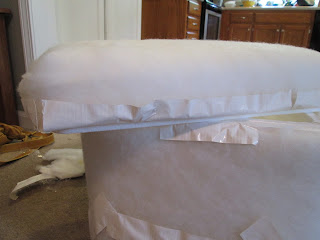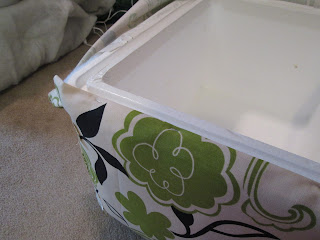We bought this organ for $80 at an auction. It is a Kimball reed parlor organ. Matt looked up the serial numbers on the back and we think the organ was made around 1895, according to the information we found.
Here are the things that needed to be fixed on the organ:
1. The Flute Forte and Treble Coupler stops did not work.
2. Two keys stopped playing at some point.
3. A rod hooked to the volume control rubbed a piece in the back of the organ.
4. The front piece of the organ leaned forward.
5. The biggest problem: the right pedal did not pump.
Here are the things that are now fixed on the organ:
1. All the stops are in working order.
2. All the keys play.
3. The volume control is adjusted
4. The front piece now stands vertical.
5. The right pump strap has been replaced.
That's right, everything on our organ is fixed! The best part is that everything was fixed by Matt and I -- well, mostly Matt, our the organ doctor. I called someone last week whose card we'd seen in Blackwater, Missouri, about coming to look at and possibly fix the pump on the organ. I was going to surprise Matt, but I ended up mentioning it to him and he said he really wanted to take a look at the organ to see if we could fix it first. We had seen a loose piece of fabric when we were moving it in, and we thought it might just be that the strap had broken and needed to be reattached or replaced. So, I said we could look at the organ and if Matt could fix the strap I would call the guy back.
On the night before Matt had to leave for a short business trip, we
started looking at parts of the organ. We opened up the back of the
organ first, where we could see the stops. The stops are the long black tubes. As you can see in the picture below, they have small wood strips coming out of them that attach to metal rods below the stops. When pulled out from the front of the organ, the stops pull forward those wood pieces that in turn press the rods forward a bit. The rods bend and connect to other wooden pieces and more rods in a maze that moves parts of the organ. For example, we later learned (when we removed the piece in front of the keys) that using the Flute Forte opens a slat that allows air coming from the bellows past the reeds to exit more easily, therefore making the treble end of the organ louder.
 | ||
| Treble-end stops from the back. |
 |
| Far edge of the treble-end of the organ. See the rods? |
 |
| Matt working on treble-end, using a shim to hold a rod in place. |
So, to fix one of the stops, Matt had to put the wooden strip that comes out of the stop back over its rod. It just wasn't hooked over the rod, so it wasn't pushing the rod forward when we pulled the stop. Easy fix.
The second stop needed to have a shim put in the wooden piece that attached it to another rod that connected to the slats and workings at the front of the organ (sorry, I can tell this is getting ambiguous, but I don't exactly know all the correct terms, so I'm trying my best to identify pieces as best I can). The nut that held the rod to the wood piece at the back of the organ kept slipping and losing pressure, so Matt filled in the rest of the hole in the wooden piece to keep the rod in place and force it to push the connector forward when the stop was pulled out.
 |
| Front of organ without the decorative covering. |
Whew, that was a bit confusing. Step two is easier to explain. After fixing the stops, we moved to the front of the organ. Matt removed the piece that hides the space under the keys. This is where we learned a lot about our organ!
We could see the reeds when pumping the bellows and watching very closely beneath the keys. Matt found the two keys that weren't working. On a low A, there was a spider sac in the way of the reed vibrating (gross!). On a very high E, Matt cleaned the reed with a Q-tip and that seemed to do the trick. Apparently enough dust can clog them up.
 |
| Wooden rods and metal strips beneath the keys. |
After this, Matt was looking at the back of the organ again and noticed that a piece of wood was rubbing on the key-cover when the key-cover was pushed up. After a bit of following rods, we saw that the rod that connected to the piece of wood was connected on the other end to what we call the volume control paddles. The paddles are used with a player's knees. While playing, you can slightly shift the paddles. Then they will hit two metal rods sticking down from organ, right under the keyboard, and those rods will move and will do the same things the stops do, but for a temporary amount of time (as long as you hold the paddle there). For example, whereas having the Bass Coupler stop pulled out will make it so that every time you play a bass note a corresponding note of an octave lower will also play, using the volume control can activate the Bass Coupler in the middle of playing so you don't have to reach up and pull out a stop, or have the effect last the whole time. The paddles can also open up those slats that let out more air, which is why we call them volume control.
Anyway, the paddle and rod were not lined up right, but Matt shifted them so that the piece of wood in the back of the organ no longer rubs against the key-cover.
After this we made the front piece stand more vertically. Matt looked in the back and saw that a nail holding the façade forward was not pressing forward far enough, so he nailed it in a bit farther. That helped some, but the facade still leaned somewhat. So, we used some shims to try to hold it in place. This worked temporarily, but a few days later it shifted again a bit. We'll keep working on ways to make it fit perfectly. So, I guess that part is not completely fixed, but it is much better than it was.
All right, finally, the big fix!
 |
| Behind a part of the façade, showing the straps, uh, strap. |
We found we could unscrew a part of the organ façade that was right above the pedals and have a look at the straps. The straps are pulled down when the pedals are pressed. They roll over a wooden roller and pull the bellows open, pumping air up past the reeds and making the organ play. One strap, as we thought, was broken. In fact, it looked as if the straps had both been broken at different points, as it appeared that someone had tried to fix them with overall straps! They were haphazardly sewn onto the straps ... but one was working, while the other had rotted and broken again.
By the time we'd fixed all the other problems, it was late on the night before Matt's trip, so we put off the actual fixing of the strap. But, since I was so impressed with Matt figuring out how to fix the other problems that I went ahead and called the organ man the next day and said we were going to try to replace it on our own first. When Matt returned, I had sewn two new strips with canvas I had, ready to replace the straps. We ended up only replacing the broken one, but I kept the other new strap for the future, in case the other "original" strap breaks.
 |
| That screwed wood piece attaches the strap to the bellows. |
Matt pulled out the nail that held the pedal up. We used a compact mirror to look behind the pedal because it would not lift up high enough for us to see behind. Matt unscrewed the wooden pieces that attached the straps, we measured it out to match the other strap, and we screwed them back on with the new strap attached.
 |
| Pedal without strap attached. |
 |
| Using the mirror to see what we were doing. |
 |
| Attaching the new strap to the wood piece, then the pedal. |
 |
| Screwing the strap to the bellows. |
And there you have it, the organ is all fixed! We had a fun celebration of our accomplishment - kitty even got Fancy Feast - and we've been playing it a ton over the past few days. I still have to get used to pumping rather than just playing (not a piano!). Still, it is so exciting to have our organ fully working. When we first got it, we were not sure if it would work at all, and thought it might just have to be "furniture" for a while, but we are both so happy that it works and I am especially excited that Matt has been playing it so much. He really enjoys it and it is cool to see him teaching himself some songs.










































